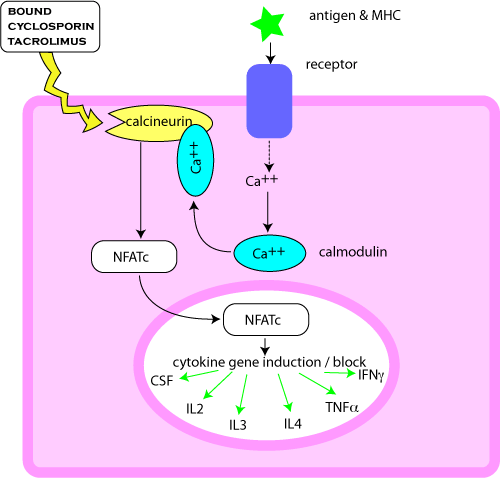

Very commonly used in small and large animal veterinary practice as immunosuppressives at higher doses than used for anti-inflammatory effects (nb, there is still a small immunosuppressant effect at low doses). Duration of action varies greatly. Prednisone, prednisolone (probably the most commonly used immunosuppressants) and triamcinolone are of medium duration of action whereas dexamethasone and betamethasone are long acting. The duration of action of these drugs is further influenced by the chemical form of the glucocorticoid in the preparation. (see corticosteroid notes). Generally, prednisolone (or prednisone) is used for twice daily dosing (at about five times the anti-inflammatory dose), or dexamethasone for daily / alternate day dosing. The dose is tapered down to what works in that individual.
Immunosuppressive properties include:
•depression of antibody production especially of new antibodies or inappropriate (eg autoimmune) antibodies
•depression of migration of immune cells
•depression of cytokine release
•may be lympholytic in high doses
•decreased uptake of antigen by reticuloendothelial cells
•at massive doses glucocorticoids inhibit mitosis by stopping cell cycle in M phase
Side-effects in dogs
(see corticosteroid notes)
Effects on laboratory values
•stress leukogram (neutrophilia without left shift, lymphopaenia, eosinopaenia)
•elevated serum alkaline phosphatase (SAP) (dogs only)
•elevated ALT
•lipaemia
•increased blood albumin
Antihistamines are mainly used for management of allergic conditions (H1 -blockers) of the skin. Most commonly used as glucocorticoid-sparing agents as they are not usually effective by themselves. Most modern antihistamines are designed to be non sedative (in people) but sedation is often useful in dogs so older drugs, mostly phenothiazines such as acepromazine, promethazine and trimeprazine, tend to be used. Second generation drugs such as chlorpheniramine are also useful in dogs. There are dozens of more modern drugs, most of which have not been assessed in dogs and cats.
The only licensed drug in NZ is tripelennamine but it is not recommended as an antihistamine. When given iv to ruminants, it appears to block H3 receptors in the CNS increasing arousal / making them convulse. Has been used to get downer cows up but not recommended!
Cyclosporin (cyclosporine USAN, ciclosporin INN) is a potent inhibitor of T lymphocyte activation halting the immune response. Its main use has been to prevent graft rejection (in man); its main use in vet medicine is topical treatment of keratoconjunctivitis sicca as an eye drop, but it is also used for anal furunculosis and atopic skin disease.

Cyclosporin's mechanism of action.
It is too expensive for routine use in other immune-mediated diseases, and therapeutic drug monitoring is advisable if it is used systemically. Kidney toxicity is a problem in people, but does not seem to occur in dogs and cats. It has been given with P450 inhibitors such as ketoconazole to reduce metabolism, and thus dose and cost.
Newer, homologues such as tacrolimus are starting to come onto the human market. Both bind to numerous receptors in the brain as well as interfering with steroid receptor binding. Tacrolimus crosses intact skin better than cyclosporin and ahs been used for anal furunculosis in dogs.
Gold, as an organic salt, eg aurothioglucose; aurothiomaleate (= aurothiosuccinate USAN) is sometimes used by intramuscular injection in the dog and cat. Its mechanism of action is not known but appears to "normalize" immune function and decrease phagocytic activity. Its main use in veterinary medicine is chronic arthritis and feline idiopathic gingivitis-pharyngitis. Gold’s most common side-effect is thrombocytopaenia. It is expensive.
A variety of cancer chemotherapeutic drugs are used when potent immunosuppression is required. Azathioprine (Imuran) is the least toxic and most commonly used in dogs (often in combination with steroids). It is a prodrug for mercaptopurine, a synthetic purine which interferes with DNA and RNA formation, resulting in inhibition of antigen-induced lymphocyte transformation and a slow decline in antibody levels
Azathioprine is mainly used in dogs when long term, moderately potent immunosuppression is needed, but is often used when long term prednisone is resulting in unacceptable side effects. The addition of azathioprine to the treatment regimen usually allows the prednisone dose to be at least halved and sometimes eliminated.
A lag effect of several weeks should be expected before the beneficial effects of azathioprine become apparent.
The most important side effect is bone marrow suppression. Mild suppression is common with this drug and of little concern. Severe depression is rare, is most often seen early in the treatment protocol, is more common in cats than in dogs, and is usually reversible on discontinuation of therapy. A complete blood count should be performed every 10- 14 days for the first 2-3 months of therapy and should be repeated at monthly to bimonthly intervals thereafter. Treatment with azathioprine should stop if marked neutropaenia or thrombocytopaenia develop.
If more potent immunosuppression is required, other anticancer drugs are used, eg. cyclophosphamide, chlorambucil (see below for more detail). Newer drugs such as mycophenolate are being used in people as immunosuppressives because they are relatively specific for T and B cells, but there is no information on their use in animals yet. IL2 receptor antagonists such as basiliximab and daclizimab are occasionally used in people but are mind-bogglingly expensive.